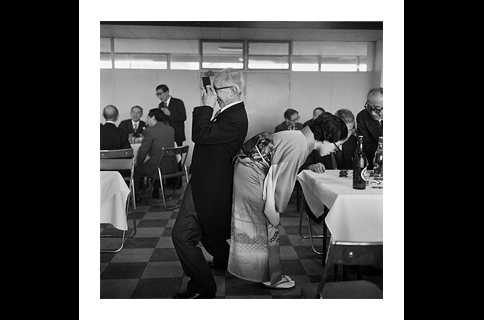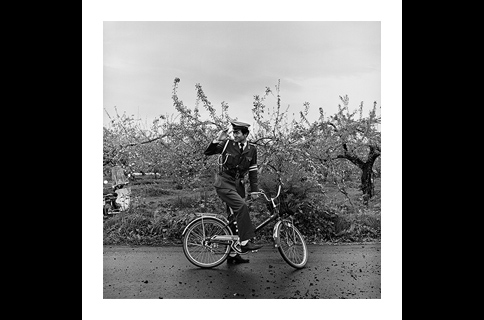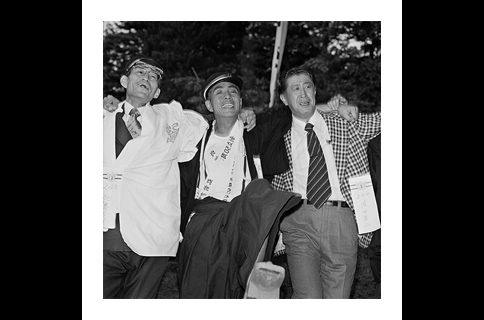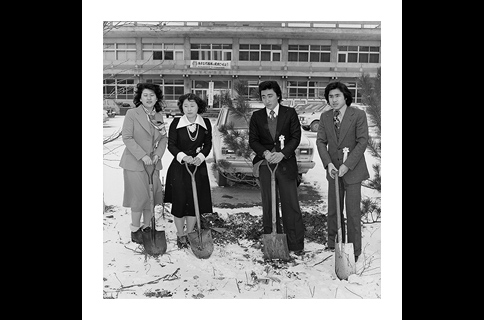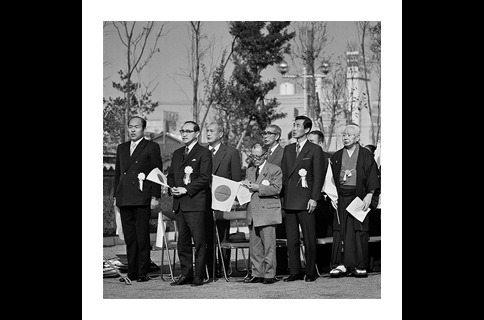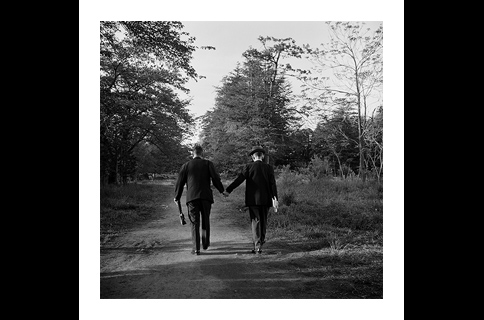- Home
- Exhibitions & Events
- Ryoji Akiyama Tsugaru: Ryōji-sensei gyōjōki (Tale of Tsugaru by Ryoji-sensei)
FUJIFILM SQUARE Photo History Museum Exhibition
Ryoji Akiyama
Tsugaru: Ryōji-sensei gyōjōki (Tale of Tsugaru by Ryoji-sensei)
Ryoji Akiyama (1942—) is one of the principal photographers of postwar Japan. His photographs of the people and the sights he has come across on his travels and sojourns in Japan and abroad are captured with a unique sense of distance and timing, and highly acclaimed both internationally and in Japan.
After working at the Tokyo bureau of The Associated Press (AP) and the photography department at Asahi Shimbun, Akiyama became a freelance photographer in 1967. At first, he actively documented social issues such as starvation in India or depopulation on the remote island of Hachijojima with the eye of a photojournalist, but he gradually came to recognize that he was not cut out for journalism. Realizing the importance of looking more closely at his own surroundings, Akiyama drew close to the people he encountered on his travels and in the places where he stayed, adapting his creative style toward photographs that reveal his sense of warmth toward the sights he saw.
Published in 1978 as Akiyama's first collection of photographs, Tsugaru: Ryōji-sensei gyōjōki is an early masterpiece. About seven years after setting up as an independent photographer, Akiyama made up his mind to leave Tokyo for a time and to live somewhere else where he would create new work based on a unique concept. His idea was to dispatch himself to a regional city as the correspondent for a fictional news bureau, thinking that something would emerge out of the photographs of daily life that he dispatched in his reports to the fictional head office. Akiyama moved with his family to Hirosaki in Aomori prefecture, where they stayed from the summer of 1975 to the spring of 1977. Here, Akiyama assumed his fictional role, recording the time he spent in the Tsugaru area and the people he encountered in loving and lighthearted photographs. These photographs capture the culture of a regional city that was thriving in the postwar period of rapid economic growth, but they also reflect the warm gaze of a sympathetic photographer and, if only for a moment, the daily lives and subtleties of life in Tsugaru among people who shared a particular place and time.
This exhibition shows newly produced original prints of thirty carefully selected images taken over approximately two years from 1975 and published in Akiyama's masterpiece Tsugaru: Ryōji-sensei gyōjōki. Today, more than forty years have passed since these images were taken, and, in step with the changing times, photography has undergone a technical and conceptual transformation. However, the photographs that Akiyama took in Tsugaru in the 1970s vividly express the starting point for photography, which is to record a particular moment. These photographs are imprinted with singular moments in the lives of these people and an era that could only be captured then and there. The atmosphere of old-fashioned Japan and the warmth shared among the people in Akiyama's photographs may feel nostalgic to one generation and fresh to another, but they also provide us, who live in the modern world, with moments of peace and a new way of looking.
We hope you will enjoy the warm and witty take on the world of photographer Ryoji Akiyama.
Profile of the Photographer
Ryoji Akiyama (1942—)
Ryoji Akiyama was born in Tokyo in 1942. His father, Seiji Akiyama (1905—1978), was also a photographer. After graduating from the School of Humanities and Social Studies at Waseda University in 1964, Akiyama went to work at the Tokyo Bureau of The Associated Press and the photography department at Asahi Shimbun newspaper before becoming a freelance photographer in 1967. As a photojournalist, he covered and published work on social issues in Japan and abroad. In 1974, his photographs were shown alongside those of Daido Moriyama and Masahisa Fukase and others at the New Japanese Photography exhibition at the Museum of Modern Art (MoMA) in New York. Subsequently, he established an original world of photography, presenting unique works taken during his travels and sojourns in Japan, China, and the United States. His most important photobooks are Tsugaru: Ryōji-sensei gyōjōki (Tsugaru Shobo, 1978), New York Tsūshin (Dispatches from New York) (Bokusuisha, 1980), Narakawa-mura (Narakawa village) (Asahi Shimbunsha, 1991), Nara (Yujinkobo 2006), and in translation, This Fabulous Century 1900–1910 (Seibu Time, 1985), as well as Sensu no kemuri (Hosokai, 2014), a collection of essays. His photographs are in the collections at MoMA, the Tokyo Photographic Art Museum, the Aomori Museum of Art, and others.
In recent years, a re-evaluation of Akiyama's work has been underway. The reprint of Ni hao xiao peng you—Chugoku no kodomotachi (Dear Old Days), a photobook first published in 1983, and Guang jing wan ru zuo—Chugoku no kodomotachi II (Dear Old Days II), with previously unpublished work for the series (both from Seisodo), have been very well received when released in Japan and China.
| Title | FUJIFILM SQUARE Photo History Museum Exhibition Ryoji Akiyama Tsugaru: Ryōji-sensei gyōjōki (Tale of Tsugaru by Ryoji-sensei) |
|---|---|
| Period |
January 4 — March 31, 2021 10:00 — 19:00 (The exhibition closes at 16:00 on the final day. Last admission is ten minutes before closing.) Open every day |
| Number of works | 30 works |
| Venue | The Photo History Museum at FUJIFILM SQUARE (Tokyo Midtown West) |
| Admission | Free |
| Organized by | FUJIFILM Corporation |
| Supported by | Minato City Board of Education |
| Planning by | Photo Classic |
* Please note that circumstances may force us to suspend or modify the exhibition or the events. Thank you for your understanding.
Photography Exhibition Related Events
Interview Series No. 4 Talking about Tsugaru: Ryōji-sensei gyōjōki (provisional title)
The interview with photographer Ryoji Akiyama will be published on our website in early February (Japanese only).

In 2020, The FUJIFILM SQUARE Photo History Museum was recognized by the Association for Corporate Support of the Arts for “contributions to society through the promotion of arts and culture” and has been authorized to use the “THIS IS MECENAT 2020” logo.



